A lack of moisture in the soil affects potatoes a lot. The formation of tubers and leaves requires a normal metabolism, which can only be achieved if there is a sufficient amount of fluid. Excess water is also harmful, so knowing how and when to water the plants is useful in order to achieve a good harvest.
Content
Do I need to water potatoes
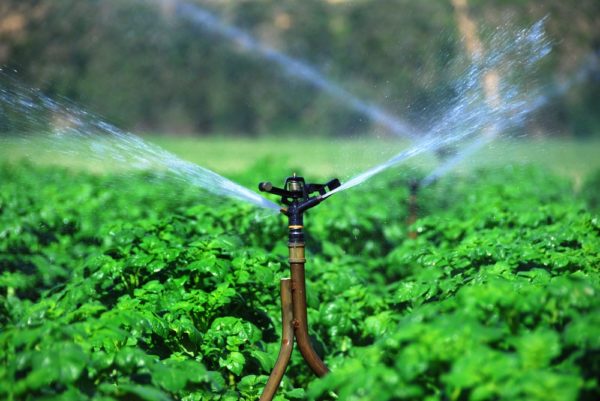
The roots of this plant are powerful, but not too long: on average they penetrate the soil by 30 centimeters. It is quite difficult to independently produce fluid in such a layer, so the soil must be well moistened. Part can be obtained during the rain, but in dry times, watering the beds is especially important. This is characteristic of all varieties of potatoes: both early and those that ripen later. You can monitor the condition of the bushes by external signs.
Despite the fact that the potato seems to be a fairly dry fruit, the plant has abundant green tops, which need water for good metabolism and photosynthesis. And in the seemingly dense tubers there is actually a lot of juice. If there is little water in the soil, then the potato tops begin, like a weed, to pull nutrients from the root, making the tubers sluggish, small. Moisture deficiency can slow down, and sometimes even completely stop growth. Therefore, watering is very important for the crop.
Under favorable conditions, some varieties grow well without watering. To do this, read the information on a specific variety, take into account the climate of the region, the state of the soil, the amount of rain. To save moisture in the soil and reduce the amount of watering, you can use mulching. This procedure, as it were, conserves part of the soil and allows you to forget about the water for a while.
If your region often rains, then the soil can be not watered, but simply loosened. Mix the wet and dry layers so that the soil is properly saturated. Loosening improves aeration and helps the roots to extract nutrients from the soil. At the same time, the land should be fertile and saturated: sandy soils must be watered. The main thing is that the soil layer is moistened to a depth of 5 to 7 centimeters, then you can not worry about potatoes.
Like other vegetables, potatoes are sensitive to sudden changes in humidity. Try to match the climate of the region. In some areas, watering is necessary, while in others it can even do harm due to fluid accumulation. So the question of whether to water potatoes depends on the soil, climate in your region.
Watering potatoes: deadlines
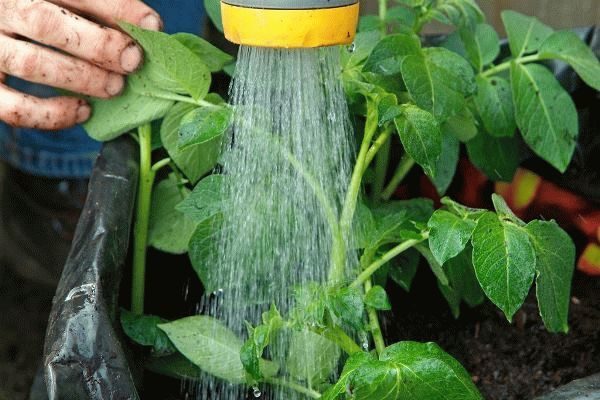
Immediately after planting crops on the beds watering is not required. The soil still retained moisture after the cold season. There will be enough liquid for a long time: until the tops grow by 10-12 centimeters, you can not remember about watering. Potatoes will draw moisture from the earth and air, if the climate allows. The need for liquid increases sharply during the period of active growth of greens: then just then you should start watering the crops.
Water is especially important:- two weeks after planting, during the active phase of vegetation;
- after the formation of the first inflorescences, when tubers form;
- when potatoes gain mass.
Five weeks after the germination of the sprouts, the plants begin to experience a deficiency of fluid. Water is required to saturate the fruit, form buds, and strengthen the root system. Watering potatoes during flowering is especially important. During this period, from 4 to 12 liters of water will go to each bush for you. The irrigation rate depends on the condition of the beds and the temperature on the street. Active tuber growth usually begins in the 10th-20th of August. The time will be different, the landing time and climate are important.
Stop abundant watering when the tops gradually begin to dry out. If everything else is fine with the plant, then this signals an early ripening. Excess moisture is no longer needed at this stage, so keep it to a minimum. 2 weeks before harvesting, you can completely stop watering the potatoes.
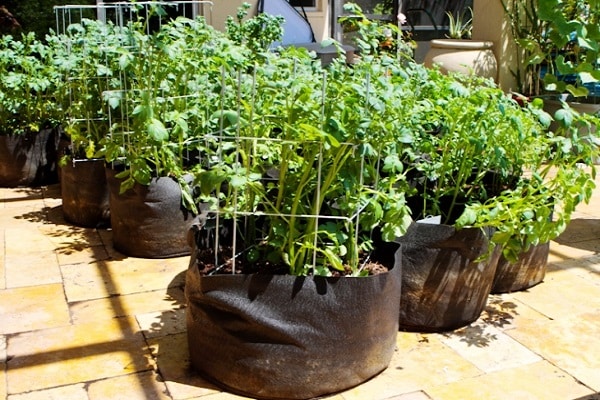 You may be interested in:
You may be interested in:How often to water potatoes in open ground
At each stage, watering plays a role. Moisturizing during planting allows the first sprouts to hatch faster, contributes to the development of the green part. When flowering, a sufficient amount of water increases productivity: the plant has the strength and resources to form tubers. In the later stages, moisture improves the condition of the tubers, makes them more saturated and large.
In comfortable and favorable conditions, one watering once every 10 days is enough. During this period, the average amount of water is 8-12 liters. When the first signs of drying appear, the amount of water can be increased. The main thing is not to fill the potatoes too much: it also harms him. When the tubers begin to form, add a few more liters and water a couple of times a week.
Moisture is always required for plants, but especially in a hot and arid period. The absence of rain deprives the soil of moisture, and the plants just enter the active phase of the formation of the fruit. In direct sunlight and high temperatures, the liquid evaporates much faster. Therefore, you need to water the beds regularly. Water the crops once every five days or more often. Focus on the soil: it should be moist on the entire top layer. Water the plants in the evening or in the morning.
Early potato
Early varieties require special conditions as they grow faster. Lack of moisture for them can be fatal: the yield and size of tubers decreases sharply. Keep track of the growing season, make up for the lack of substances on time. Then even the earliest potato varieties will grow without loss.
The frequency of watering for early ripe potatoes will be higher, and the amount of liquid - less. Do not allow the soil to dry, otherwise tubers may simply not have time to form. Most of the moisture required by the bushes during flowering and fruit formation. Irrigation methods are suitable for any: from irrigation or automatic irrigation system to the classic root. Early varieties are best grown in prepared soil. The lack of nutrients can be filled with fertilizers and sprayed with special solutions with the addition of minerals.
Signs of excess and water scarcity
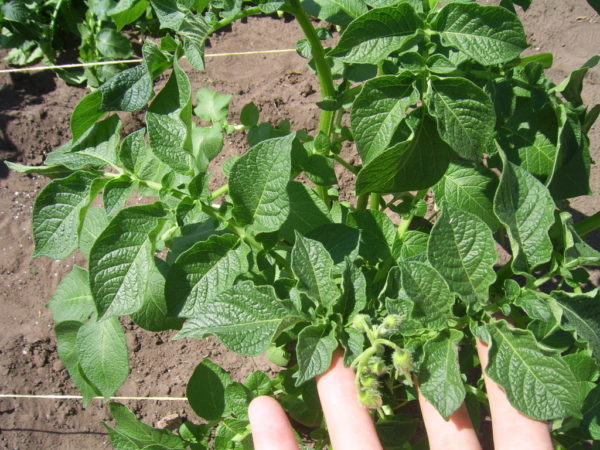
All errors in irrigation affect the condition of the bushes. Problems appear externally, so regularly inspect the plants to prevent unpleasant consequences. Both a lack of water and its excess are harmful. In the first case, you will get dried, sluggish fruits, in the second - watery or even sick.With a lack:
- growth slows down;
- the leaves brighten and begin to fall;
- potatoes do not bloom;
- the buds remain unopened;
- the stems weaken and dry.
Excess water is more difficult to notice. Most often, at an advanced stage, rotting of tubers begins, potatoes are affected by diseases and fungal infections. But here there are common external signs that will help to recognize the problem:
- water content of foliage;
- the appearance of spots near the stem;
- the development and spread of fungus;
- darkening of the bottom of the leaves near the ground.
Types of Irrigation
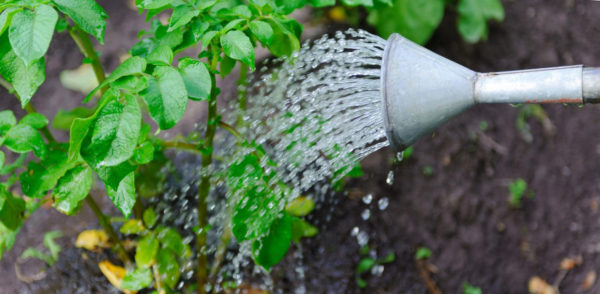
You can moisten crops in many ways. Water under the root or grooves, irrigate the beds. Dry watering, loosening the soil or mulching with organic and inorganic materials will help maintain moisture in difficult conditions. You need to choose a method according to the amount of precipitation, the size of the garden and the possibilities for irrigation. If you often leave and cannot regularly check the condition of the earth, mulch it or install an automatic system.
Root
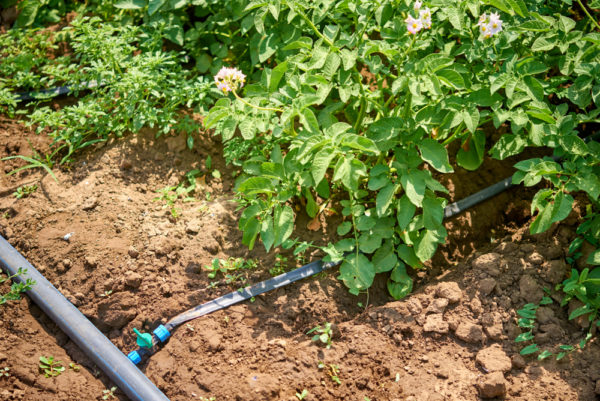
The classic way, suitable for a small landing area. Its main advantage: it is completely manual and individual, so you can personally control the amount of fluid for each plant, evaluating its condition. In large areas, this approach is practically not used. Try not to fill the stem and leaves, moistening only the ground. Often you don’t need to water the potatoes: it can only do much harm.
Grooves
On a large area in the household, the groove method is often used. Water is poured into the deep channels between the beds, blocking the outlet so that the liquid does not spill throughout the garden. After a couple of days, the soil is loosened in blurry areas. The water consumption is large, but you can not worry about watering for a long time: the soil will be moistened gradually. This watering of potatoes is well suited for the middle phase of growth, until the plant has finished forming the fruits. Further excess moisture will harm.
Spraying and drops
To save water, they use methods that simulate rain. They make the jet very weak, often use a nozzle that disperses water in the manner of a shower. This method carefully treats the root system, does not wash the ground. It is important to loosen the ground regularly, otherwise the layer will become too dense. With the amount of water you can easily overdo it, which will lead to the development of fungus and infections. And do not pour potatoes with cold water: this will reduce its resistance to disease.
Automated drip irrigation is economical and practical. The irrigation system allows you to keep the soil moisture level normal, but the installations are expensive, therefore they are often used only in large farms. Irrigation of potatoes is the closest to the natural way. You can use it after flowering to maintain humidity at the right level.
Dry watering
This method consists in loosening and hilling. It improves aeration of the soil, saturates the earth with air. Regular cultivation is beneficial for the root system, which results in an improvement in the condition of the whole plant. To get the effect you need to follow a few rules:
- Spud beds immediately after the first wetting.
- Fully cover the overgrown part of the potato with earth.
- Before the appearance of flowers, you need to have time to do this three times.
- After flowering, be sure to plow the space between the rows without damaging the growing tubers.
Dry watering is more of an addition to care. To grow a good harvest, water the potatoes correctly at least several times after you have planted it.
Mulching
If you rarely appear in the country and cannot water the plants regularly, mulch the soil. This will help keep the earth moist. Organics are well suited for sheltering crops. The desired effect will have straw or sawdust. Rotting, this mulch becomes humus, additionally moistening the soil. It is easy to move the straw to check the condition of the soil. If you notice that it is losing moisture - water the beds.
The question is whether watering potatoes is controversial enough. It all depends on the climate, region, soil temperature and its composition. In some regions, watering is required regularly; without it, potatoes simply will not germinate. And in others, enough dry watering or natural moisture from regular rains. You can balance the amount of moisture using mulching. The protective layer will not only keep the earth moist for a long time, but also increase the nutritional value of the soil. Watering potatoes after planting is not necessary. It is optimal to do this several times during the season, after the first leaves hatch.




 Description and description of varieties in Belarus with a photo
Description and description of varieties in Belarus with a photo Do I need to pick flowers from potatoes: why do they do it
Do I need to pick flowers from potatoes: why do they do it When to dig potatoes: timing and availability of new potatoes
When to dig potatoes: timing and availability of new potatoes How to grow a good potato crop: various methods and methods, planting and care
How to grow a good potato crop: various methods and methods, planting and care